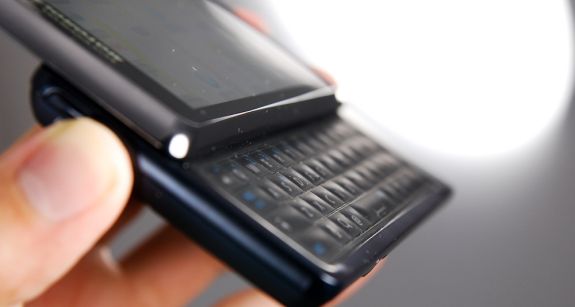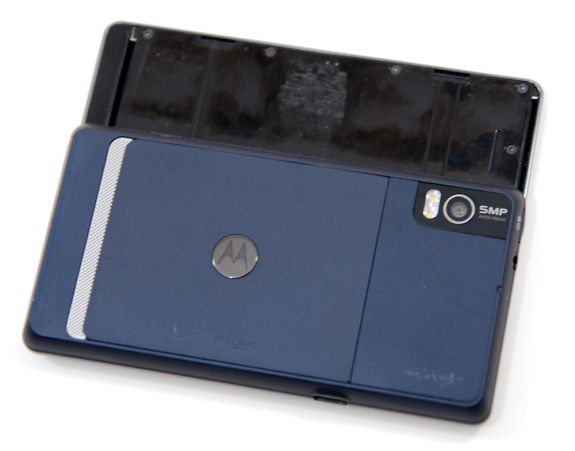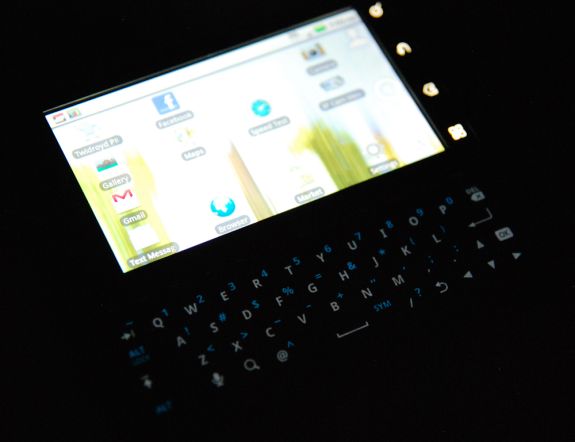Motorola Droid 2 Review: Rebooting the Droid
by Brian Klug on September 19, 2010 7:00 AM EST- Posted in
- Smartphones
- Droid
- Motorola Droid 2
- Android
- Mobile
Finally, a usable hardware keyboard
Of course, what’s really changed about the Droid 2 is the keyboard. I reviewed the original Droid a while back, and talked a lot about why I found the first Droid’s keyboard frustrating to the point of being unusable. What I was missing however was perspective on the original Droid’s refreshed keyboard, which has somewhat raised keys, and thus much better feedback.
If you’re contemplating upgrading from the original device, just how much better the Droid 2’s keyboard will feel to you is purely a function of which revision of the original Droid you’re coming from. If you were an early adopter and got the first one, the difference is dramatic to the point of earth shattering. Most people I know with the first revision, concave-key sporting version don’t even use the hardware keyboard. However, if you’ve already got a later revision from hopping onboard later or RMA, the difference isn’t nearly as dramatic.

Motorola Droid (original) Keyboard
The oversized Dpad is gone, which is good for most things as it just didn’t serve much purpose in Android, but did have get use in some game emulators and other programs. Android developers are likely going to build interaction paradigms around whatever inputs are present on a majority of devices, and there just doesn’t seem to be a majority of Android handsets with Dpads or optical trackpads. You’re not totally screwed if you needed directional controls, however, as the Droid 2 maintains up down left and right keys in the bottom right. What’s really nice about the Droid 2 keyboard is that the space picked up from ditching the DPad has been put to really good use. The keyboard is arranged in an offset pattern just like a real QWERTY keyboard should be.
The domes themselves are also convex, just like they always should have been. Even better are raised bars on j and f for index finger placement—again, just like a real keyboard.
There are dedicated search, microphone input, back, and ok buttons as well. The result is that with the exception of home, all of the capacitive buttons are present in landscape mode as well. There’s alt-lock in the place of caps lock, which is a bit odd, but everything you’d expect is here.
The keyboard slider assembly is likewise unchanged from the original Droid. There’s no spring assist—just friction. There are thankfully two clicks for keeping the phone in the closed or open position, but nothing more. Sliding the tray open and closed is smooth, but not very.
After a week of use—greasy glossy back and scrapes from sliding mechanism
I don’t think anyone will complain about it, and don’t get me wrong—it isn’t a problem—but I’m left wondering why Motorola seriously couldn’t add two strips of Teflon to the slider and make it feel smooth as glass. HTC has done it forever.
As it stands, you can clearly see the slider assembly making marks on the glossy back of the display, which begs another question: why the heck is this so glossy? Regardless, the addition of some teflon would make the Droid 2’s slider rightfully feel like a piece of precision engineering or an expensive micrometer. Otherwise, it feels forced and a bit cheap. There’s also one or two degrees of oreo effect when the keyboard tray is closed. In the open position, the mechanism is completely solid.
The Droid 2's backlighting is adequate, but just a bit understated. I didn't have problems finding keys in the dark, but they're not super bright, just lit.
On the whole, the Droid 2 feels much the same as the original device. What’s different is that Motorola has worked out the few hardware oddities (like that chin at the bottom) and smoothed over the hardware’s rough spots. Literally smoothed over—the 2 has gracefully rounded edges along the outside and slightly longer radius curves in most others.
The result is probably the most optimal balance between ties to the old Droid and a much needed refresh.














39 Comments
View All Comments
bjacobson - Sunday, September 19, 2010 - link
My Droid's keyboard now has very bubbled keys. Try running your fingernails down and across in the creases beteween keys. I did this a few times pressing hard, went back to typing texts, and it's made my keys bubbled like the Droid2's, even moreso in my opinion than the photograph there.Also, I believe the resistance in the sliding mechanism is the mechanical sliders; I'm pretty sure 2 teflon strips on the back of the phone won't fix that.
sotoa - Monday, September 20, 2010 - link
I like having a dpad on my droid, I just wish it was on the left side like a gamepad, and wish it had diagonals.KaRRiLLioN - Monday, September 20, 2010 - link
I bought the Droid 2 the day it came out but had to return it for several reasons, most of which I hope have been fixed. Corporate email synch had a terrible bug where it wouldn't synch contacts from Exchange if they had categories. Facebook synch would synch EVERYONE instead of just existing contacts. There was no option to change that.Most of these issues were caused by BLUR. Any idea if these items now work as advertised?
So I still have my original Droid with the original flat keyboard. I'm pretty used to it now and have no issues. I think I'll stick to this until another Android-based phone catches my eye. I wouldn't mind something like the Droid X, but I want Super AMOLED.
LoneWolf15 - Monday, September 20, 2010 - link
To fix the Facebook issue, download the Facebook app instead of using the Droid 2's "Social Networking" app.I'm not using my D2 for Exchange (we have a Google Apps Domain) but after a week, I've been very happy with my switch from a Blackberry Tour (which I was reasonably satisfied with).
PubicTheHare - Monday, September 20, 2010 - link
The best keyboard on any smart phone is found on the Epic 4G. I played with it yesterday and was amazed at the tactile feedback and overall usability.Also, I don't buy that the Droid 2 screen is brighter than the Epic/Fascinate/Captivate/Vibrant's.
I have the Fascinate and placed it side by side with the Droid 2, both in a store and against a friend's Droid 2 outdoors, and the Fascinate's display was substantially brighter and had more contrast.
Great review. It seems like Motorola is hitting it out of the ballpark with its latest phones, though I still think they have the most bland styling and their UI (Motoblur) is hideous.
I bet the OMAP processors are about 80% responsible for the impressive battery life. 9.5 hrs is ridiculous!
Thanks, Anand.
Myrandex - Monday, September 20, 2010 - link
The Keyboard does look much better than the original Droid, however it still doesn't look like it comes close to the HTC Touch Pro 2 series phone's keyboard. That one is the thing to beat in my opinion. I love the spaced out offset keys and the dedicated row of numbers at the top. I sure hope my next phone has one at least that good.Jason
silverblue - Monday, September 20, 2010 - link
...that you barely mentioned the Epic 4G and its Galaxy S variants. Not trying to justify my purchase, however the lack of a mention on even the gaming and video capture fronts was a little disappointing.MrPIppy - Monday, September 20, 2010 - link
It's interesting that the Motorola Droids have always been a huge design win for TI, even though almost no other Android phones use TI's OMAP or wireless chips. The Droid, Droid X, and Droid 2 use TI OMAP and WiLink (for WiFi/BT), instead of the almost universal combination of Qualcomm MSM+Broadcom BCM4329. Even Motorola's other Android phones (Backflip, Cliq, etc.) use MSM+BCM4329. Any idea why the Droids get the TI parts?bil3 - Tuesday, September 21, 2010 - link
Surprised that Anandtech doesn't know, but the Droid JIT performance in linpack is normal.Only Snapdragon's scorpion and cortex A9 devices have a fast 128bit FPU which the JIT is optimized for and takes full advantage of.
This is a very specific case for this operating system as it's very much Java based, JIT performance matters in many operations.
The OMAP uses the standard A8 FPU which is anemic in comparison (just like the hummingbird & co.)
The CPU itself is not bad, that's why it's fast enough in raw performance benchmarks or benchs that aren't limited by the JIT.
In all cases, the JIT still bring a good bit of performance, just not as much as on devices with a fast FPU.
Brian Klug - Tuesday, September 21, 2010 - link
Bil3,Very interesting, I wondered for a while about the performance delta being due to the A8 architecture versus Qualcomm's own Scorpion design, but couldn't find that remaining detail. Intriguing that the 128bit FPU makes such a big difference.
Awesome tidbit!
-Brian